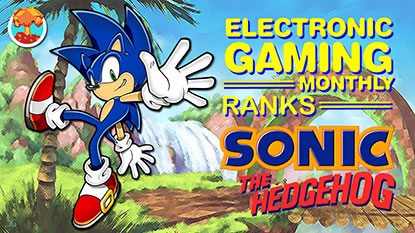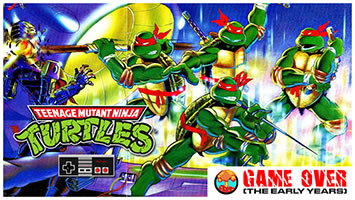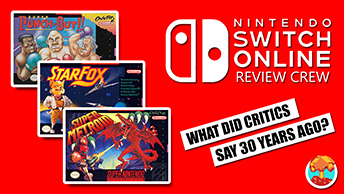- CLASSIC MAGAZINES
- REVIEW CREW
A show recapping what critics thought back
when classic games first came out! - NEXT GENERATION'S BEST & WORST
From the worst 1-star reviews to the best
5-stars can offer, this is Next Generation! - NINTENDO POWER (ARCHIVE)
Experience a variety of shows looking at the
often baffling history of Nintendo Power! - MAGAZINE RETROSPECTIVE
We're looking at the absolutely true history of
some of the most iconic game magazines ever! - SUPER PLAY'S TOP 600
The longest and most ambitious Super NES
countdown on the internet! - THEY SAID WHAT?
Debunking predictions and gossip found
in classic video game magazines! - NEXT GENERATION UNCOVERED
Cyril is back in this spin-off series, featuring the
cover critic review the art of Next Generation! - HARDCORE GAMER MAGAZING (PDF ISSUES)
Download all 36 issues of Hardcore Gamer
Magazine and relive the fun in PDF form!
- REVIEW CREW
- ELECTRONIC GAMING MONTHLY
- ELECTRONIC GAMING MONTHLY RANKS
From Mario to Sonic to Street Fighter, EGM
ranks classic game franchises and consoles! - ELECTRONIC GAMING MONTHLY BEST & WORST
Counting down EGM’s best and worst reviews
going year by year, from 1989 – 2009! - ELECTRONIC GAMING BEST & WORST AWARDS
11-part video series chronicling the ups and
downs of EGM’s Best & Worst Awards!
- ELECTRONIC GAMING MONTHLY RANKS
- GAME HISTORY
- GAME OVER: STORY BREAKDOWNS
Long-running series breaking down game
stories and analyzing their endings! - A BRIEF HISTORY OF GAMING w/ [NAME HERE]
Real history presented in a fun and pithy
format from a variety of game historians! - THE BLACK SHEEP
A series looking back at the black sheep
entries in popular game franchises! - INSTANT EXPERT
Everything you could possibly want to know
about a wide variety of gaming topics! - FREEZE FRAME
When something familiar happens in the games
industry, we're there to take a picture! - I'VE GOT YOUR NUMBER
Learn real video game history through a series
of number-themed episodes, starting at zero! - GREAT MOMENTS IN BAD ACTING
A joyous celebration of some of gaming's
absolute worst voice acting!
- GAME OVER: STORY BREAKDOWNS
- POPULAR SHOWS
- DG NEWS w/ LORNE RISELEY
Newsman Lorne Riseley hosts a regular
series looking at the hottest gaming news! - REVIEW REWIND
Cyril replays a game he reviewed 10+ years
ago to see if he got it right or wrong! - ON-RUNNING FEUDS
Defunct Games' longest-running show, with
editorials, observations and other fun oddities! - DEFUNCT GAMES QUIZ (ARCHIVE)
From online quizzes to game shows, we're
putting your video game knowledge to the test!- QUIZ: ONLINE PASS
Take a weekly quiz to see how well you know
the news and current gaming events! - QUIZ: KNOW THE GAME
One-on-one quiz show where contestants
find out if they actually know classic games! - QUIZ: THE LEADERBOARD
Can you guess the game based on the classic
review? Find out with The Leaderboard!
- QUIZ: ONLINE PASS
- DEFUNCT GAMES VS.
Cyril and the Defunct Games staff isn't afraid
to choose their favorite games and more! - CYRIL READS WORLDS OF POWER
Defunct Games recreates classic game
novelizations through the audio book format!
- DG NEWS w/ LORNE RISELEY
- COMEDY
- GAME EXPECTANCY
How long will your favorite hero live? We crunch
the numbers in this series about dying! - VIDEO GAME ADVICE
Famous game characters answer real personal
advice questions with a humorous slant! - FAKE GAMES: GUERILLA SCRAPBOOK
A long-running series about fake games and
the people who love them (covers included)! - WORST GAME EVER
A contest that attempts to create the worst
video game ever made, complete with covers! - LEVEL 1 STORIES
Literature based on the first stages of some
of your favorite classic video games! - THE COVER CRITIC
One of Defunct Games' earliest shows, Cover
Critic digs up some of the worst box art ever! - COMMERCIAL BREAK
Take a trip through some of the best and
worst video game advertisements of all time! - COMIC BOOK MODS
You've never seen comics like this before.
A curious mix of rewritten video game comics!
- GAME EXPECTANCY
- SERIES ARCHIVE
- NINTENDO SWITCH ONLINE ARCHIVE
A regularly-updated list of every Nintendo
Switch Online release, plus links to review! - PLAYSTATION PLUS CLASSIC ARCHIVE
A comprehensive list of every PlayStation
Plus classic release, including links! - RETRO-BIT PUBLISHING ARCHIVE
A regularly-updated list of every Retro-Bit
game released! - REVIEW MARATHONS w/ ADAM WALLACE
Join critic Adam Wallace as he takes us on a
classic review marathon with different themes!- DEFUNCT GAMES GOLF CLUB
Adam Wallace takes to the links to slice his way
through 72 classic golf game reviews! - 007 IN PIXELS
Adam Wallace takes on the world's greatest spy
as he reviews 15 weeks of James Bond games! - A SALUTE TO VAMPIRES
Adam Wallace is sinking his teeth into a series
covering Castlevania, BloodRayne and more! - CAPCOM'S CURSE
Adam Wallace is celebrating 13 days of Halloween
with a line-up of Capcom's scariest games! - THE FALL OF SUPERMAN
Adam Wallace is a man of steel for playing
some of the absolute worst Superman games! - THE 31 GAMES OF HALLOWEEN
Adam Wallace spends every day of October afraid
as he reviews some of the scariest games ever! - 12 WEEKS OF STAR TREK
Adam Wallace boldly goes where no critic has
gone before in this Star Trek marathon!
- DEFUNCT GAMES GOLF CLUB
- DAYS OF CHRISTMAS (ARCHIVE)
Annual holiday series with themed-episodes
that date all the way back to 2001!- 2015: 30 Ridiculous Retro Rumors
- 2014: 29 Magazines of Christmas
- 2013: 29 Questionable Power-Ups of Christmas
- 2012: 34 Theme Songs of Christmas
- 2011: 32 Game Endings of Christmas
- 2010: 31 Bonus Levels of Christmas
- 2009: 30 Genres of Christmas
- 2008: 29 Controls of Christmas
- 2007: 34 Cliches of Christmas
- 2006: 33 Consoles of Christmas
- 2005: 32 Articles of Christmas
- 2004: 31 Websites of Christmas
- 2003: 29 Issues of Christmas
- 2002: 28 Years of Christmas
- 2001: 33 Days of Christmas
- NINTENDO SWITCH ONLINE ARCHIVE
- REVIEW ARCHIVE
- FULL ARCHIVE
Ninja Gaiden: Book to Game Comparison
Now that we've worked our way through 13 episodes of Cyril Reads Ninja Gaiden, I thought it might be fun to take a look at the differences between Ninja Gaiden the book and Ninja Gaiden the game. But before we do that, I have put together a very special video that will help aid us in this comparison guide. This video runs about 24 minutes and features every cinema from the Ninja Gaiden game, along with some helpful notes I've made that will assist us as we dig deeper into the difference between the interactive story and the A.L. Singer story. So, without further ado, let's check out Ninja Gaiden: Book to Game Comparison (Pop-Up Edition)!
As expected there's a lot more back story given to these characters and their plight in the A.L. Singer book. The biggest difference is the flashback story, which takes place over three separate chapters. Yet in the game this flashback is represented by a 30 second clip of the opening cinema (only now in black and white, without audio). In the book these early chapters are some of the best, if only because it features the bumbling idiot Dr. Whimple. Whenever Dr. Randolph Whimple is around things look up, he just has a way of making everything good. But the game doesn't have any of that, instead we see Dr. Smith (Whimple's pseudonym) act like a fool and then get killed.
And that brings up the second big difference between the book and the game. For some odd reason the Ninja Gaiden book refuses to kill anybody. Neither Dr. Whimple nor Ken Hayabusa actually die, instead they are merely hurt and, in the case of Dr. Hayabusa, came back into the picture at a laughably absurd moment. It's as is A.L. Singer didn't want this story to be too depressing, even though the deaths were part of Ryu's drive in the original game. Everything in the book just seems a lot more up-beat, which probably isn't a good thing.
On the other hand, Ryu definitely had to go through a lot more in the book than he did in the actual game. Oh sure, in the game Ryu has to put up with hundreds of regular ninja characters and animals, but in the book he's falling off of mine carts, battling five bosses in a row, just barely fitting through holes in the wall, battling cars, getting kicked off of a college campus and getting in fights at a bar. While it's true that the bar fight is actually in the game, it's also true that there's no context for it in the actual game. Until I read the book I thought the creepy bar guy was part of this elaborate conspiracy to have Ryu get involved with the CIA and do their dirty work. Now I know that he was just some random loser that likes picking on ninjas.
The most jarring difference between the book and the game has to be the character's age. I think it's safe to say that in the game Ryu Hayabusa is NOT a thirteen year old boy. That's not to suggest that he's old, but he's certainly not a young teenager. Yet in the book A.L. Singer decides to turn Ryu into this young child who appears to have a death wish. There's really no reason for this change, since it just seems odd that Ryu's mother would allow her son to go half way around the world killing other people. What's more, the young age also makes the CIA stuff patently ridiculous. And don't even get me started on the girl who shoots him. Who shoots a thirteen year old kid?
And finally, I would like to end this comparison by thanking A.L. Singer for not simply reusing the terrible dialog from the video game. You could make an entire drinking game out of the amount of times Ryu says something like "..."! I mean, how on earth am I supposed to say that on a podcast? Yet in the game he's constantly "saying" that. It's interesting to see the different approaches the writers took, especially when it came to the dialog.
All in all I'm impressed with how similar these two stories are. Sure, A.L. Singer took a few liberties here and there, but for the most part he did it to make for a more compelling book. Now that we've made it all the way through Ninja Gaiden, I'm excited to see the differences between other game books. Come back in July to see how the Bionic Commando book fares against both the new and old Bionic Commando games. Trust me; you won't want to miss it!
As expected there's a lot more back story given to these characters and their plight in the A.L. Singer book. The biggest difference is the flashback story, which takes place over three separate chapters. Yet in the game this flashback is represented by a 30 second clip of the opening cinema (only now in black and white, without audio). In the book these early chapters are some of the best, if only because it features the bumbling idiot Dr. Whimple. Whenever Dr. Randolph Whimple is around things look up, he just has a way of making everything good. But the game doesn't have any of that, instead we see Dr. Smith (Whimple's pseudonym) act like a fool and then get killed.
And that brings up the second big difference between the book and the game. For some odd reason the Ninja Gaiden book refuses to kill anybody. Neither Dr. Whimple nor Ken Hayabusa actually die, instead they are merely hurt and, in the case of Dr. Hayabusa, came back into the picture at a laughably absurd moment. It's as is A.L. Singer didn't want this story to be too depressing, even though the deaths were part of Ryu's drive in the original game. Everything in the book just seems a lot more up-beat, which probably isn't a good thing.
On the other hand, Ryu definitely had to go through a lot more in the book than he did in the actual game. Oh sure, in the game Ryu has to put up with hundreds of regular ninja characters and animals, but in the book he's falling off of mine carts, battling five bosses in a row, just barely fitting through holes in the wall, battling cars, getting kicked off of a college campus and getting in fights at a bar. While it's true that the bar fight is actually in the game, it's also true that there's no context for it in the actual game. Until I read the book I thought the creepy bar guy was part of this elaborate conspiracy to have Ryu get involved with the CIA and do their dirty work. Now I know that he was just some random loser that likes picking on ninjas.
The most jarring difference between the book and the game has to be the character's age. I think it's safe to say that in the game Ryu Hayabusa is NOT a thirteen year old boy. That's not to suggest that he's old, but he's certainly not a young teenager. Yet in the book A.L. Singer decides to turn Ryu into this young child who appears to have a death wish. There's really no reason for this change, since it just seems odd that Ryu's mother would allow her son to go half way around the world killing other people. What's more, the young age also makes the CIA stuff patently ridiculous. And don't even get me started on the girl who shoots him. Who shoots a thirteen year old kid?
And finally, I would like to end this comparison by thanking A.L. Singer for not simply reusing the terrible dialog from the video game. You could make an entire drinking game out of the amount of times Ryu says something like "..."! I mean, how on earth am I supposed to say that on a podcast? Yet in the game he's constantly "saying" that. It's interesting to see the different approaches the writers took, especially when it came to the dialog.
All in all I'm impressed with how similar these two stories are. Sure, A.L. Singer took a few liberties here and there, but for the most part he did it to make for a more compelling book. Now that we've made it all the way through Ninja Gaiden, I'm excited to see the differences between other game books. Come back in July to see how the Bionic Commando book fares against both the new and old Bionic Commando games. Trust me; you won't want to miss it!
HOME |
CONTACT |
NOW HIRING |
WHAT IS DEFUNCT GAMES? |
NINTENDO SWITCH ONLINE |
RETRO-BIT PUBLISHING
Retro-Bit |
Switch Planet |
The Halcyon Show |
Same Name, Different Game |
Dragnix |
Press the Buttons
Game Zone Online | Hardcore Gamer | The Dreamcast Junkyard | Video Game Blogger
Dr Strife | Games For Lunch | Mondo Cool Cast | Boxed Pixels | Sega CD Universe | Gaming Trend
Game Zone Online | Hardcore Gamer | The Dreamcast Junkyard | Video Game Blogger
Dr Strife | Games For Lunch | Mondo Cool Cast | Boxed Pixels | Sega CD Universe | Gaming Trend
Copyright © 2001-2025 Defunct Games
All rights reserved. All trademarks are properties of their respective owners.
All rights reserved. All trademarks are properties of their respective owners.
























